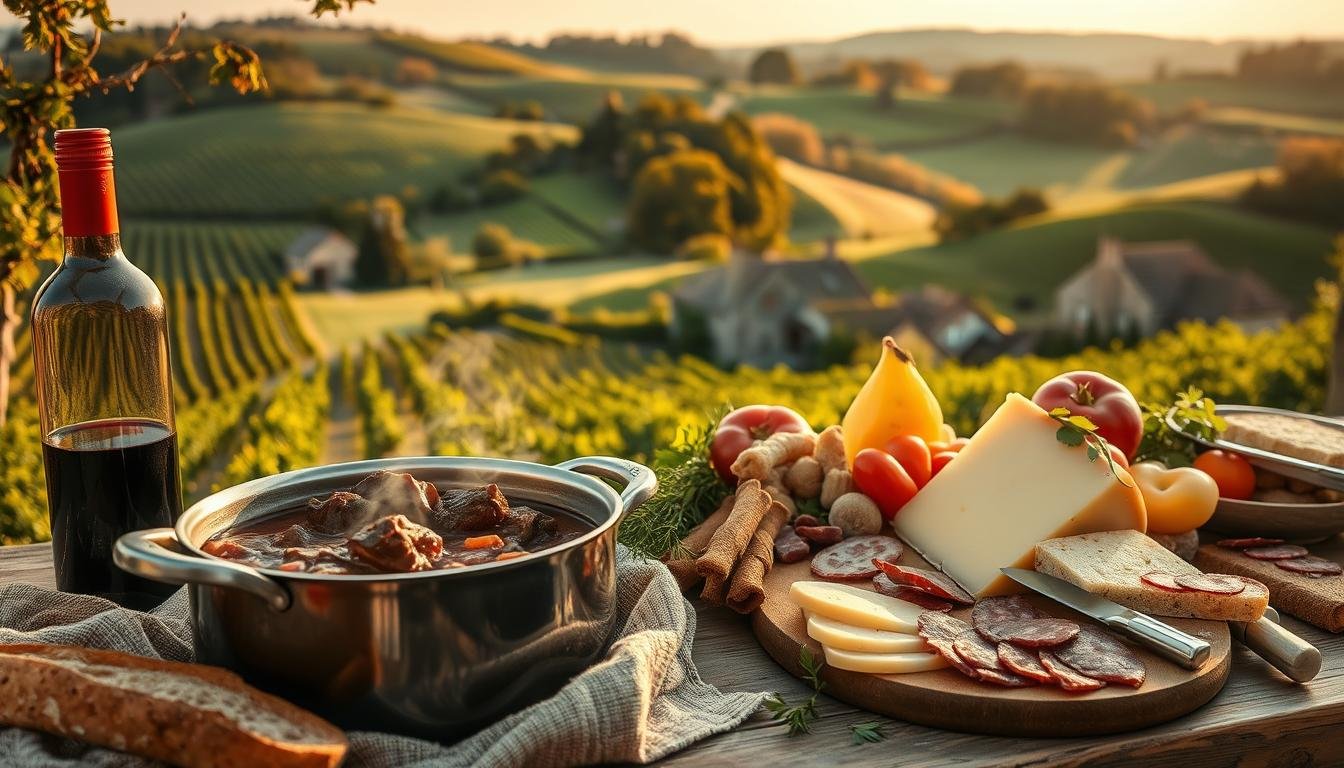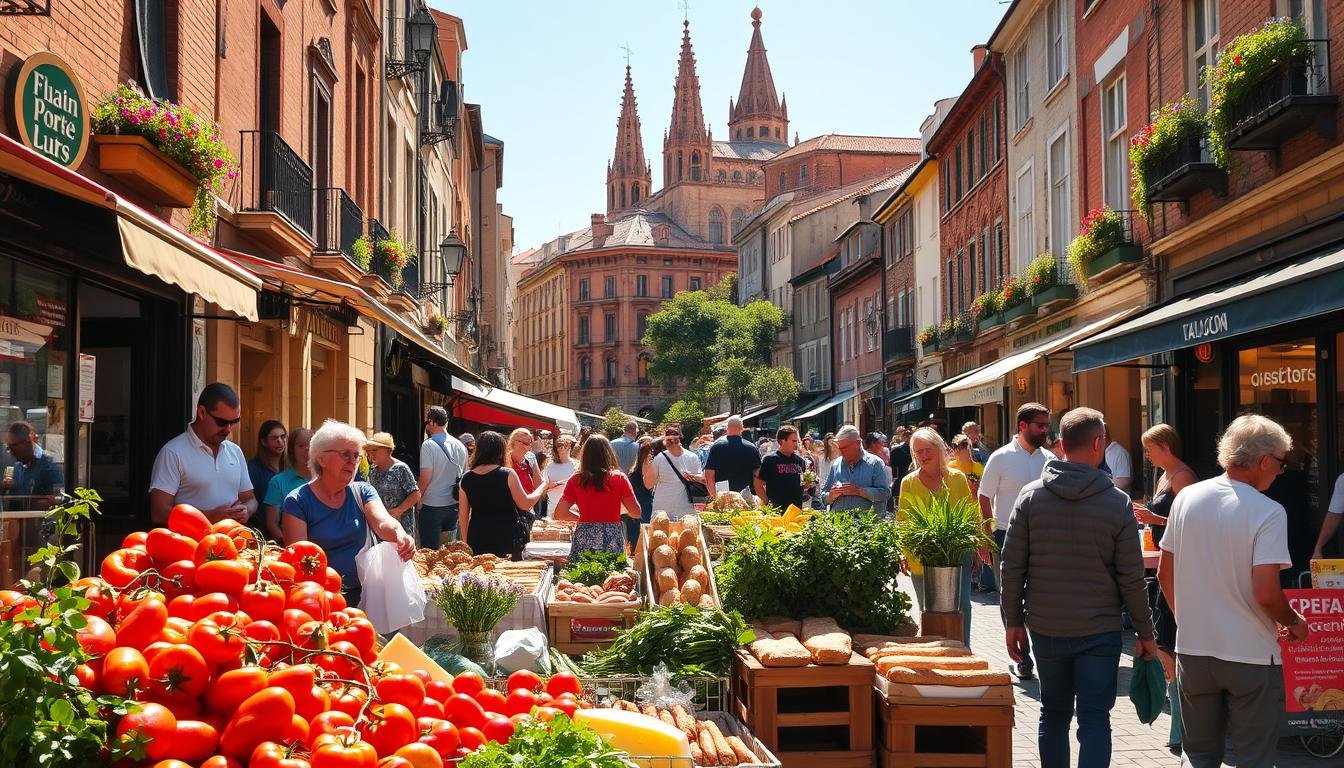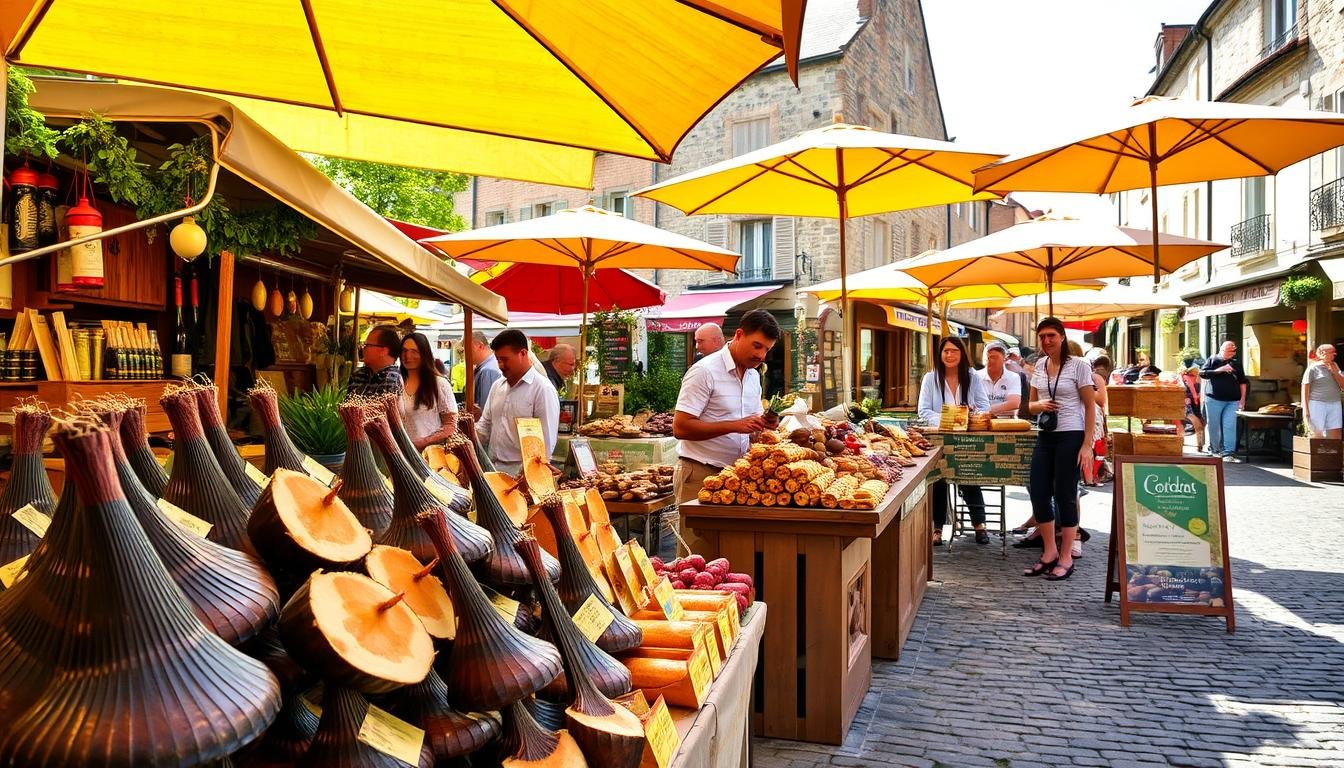
Walking through mist-kissed vineyards at dawn, you first taste the soul of Bourgogne-Franche-Comté. This region’s cuisine whispers stories of soil and seasons. Every dish, like Boeuf Bourguignon or aged Comté cheese, carries centuries of craftsmanship. Beyond the postcard-perfect landscapes lies a French regional cuisine where tradition meets terroir, a world too often overshadowed by Parisian glamour.
Imagine the tang of nutty Comté melting on your tongue beside a glass of local Pinot Noir, or the earthy aroma of wild morels sautéed in butter. This is the essence of Bourgogne-Franche-Comté gastronomy—a place where farmers’ markets overflow with truffles and charcuterie. Every meal feels like a celebration of authenticity. The region’s culinary identity blends Burgundy food tour discoveries with rituals passed through generations, from curing hams in Jura cellars to fermenting butter-rich escargots.
Key Takeaways
- Bourgogne-Franche-Comté’s hidden culinary gems redefine French regional cuisine through its cheese, wine, and rustic recipes.
- Authentic French food here thrives on seasonal ingredients and ancestral techniques untouched by modern fusion trends.
- The region’s terroir shapes its iconic dishes like Comté cheese and boar ragouts, embodying a living culinary heritage.
- Exploring its vineyards and producers offers deeper insights than typical tourist itineraries.
- Its culinary traditions remain vital, with chefs reviving ancient recipes for contemporary palates.
Embarking on a Culinary Journey to Bourgogne-Franche-Comté France
Your first morning in Dijon, start with steam from a café window. The smell of pain d’épices mixed with coffee. Eastern France’s food feels alive, not just on menus but in the air. The best Burgundy food isn’t in brochures—it’s in the hands of farmers and artisans.
Walking the cobblestones, You’ll meet a Comté cheesemaker who talks about his family’s dairy history going back to the 1800s. “The limestone soil shapes our milk,” he said, crust of an aging wheel dusted with cellar flour. This is the heart of Franche-Comté’s culinary traditions.
“Terroir isn’t a word here—it’s a way of life,” a winemaker said, pouring a glass of lightly chilled poulsard. “Every dish carries the soil’s fingerprint.”
French food tourism here isn’t about trends. It’s about tasting the mix of Germanic spice, Swiss cheese aging, and Burgundian boldness. A meal at a family bistro near Vézelay teaches you patience. Escargots simmered in garlic butter, followed by a duck confit so tender it dissolves like a memory. Each dish tells stories of crossroads—a place where cultures and flavors meet.
Eastern France’s food thrives because its guardians resist shortcuts. The region’s quiet reputation has protected its culinary soul from mass tourism. Here, every bite is a promise kept between land, history, and those brave enough to taste it.
The Historical Roots of Burgundian Cuisine
In Beaune’s ancient cellars, the scent of aged wine fills the air. Here, follow the path of Burgundian culinary history. Medieval French cuisine flourished, shaped by monks and dukes.
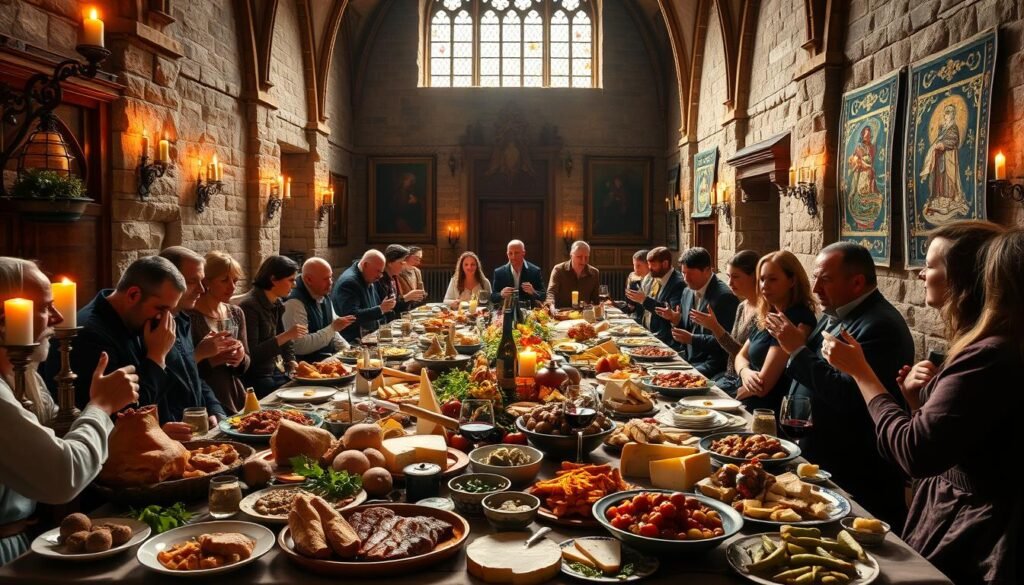
Monks in these kitchens mastered preserving food, creating dishes like potted game and herb pâtés.
Picture a 15th-century Hospices de Beaune cellar. Monks mixed vegetables and wine to make healing broths. These early dishes evolved into boeuf bourguignon and other beloved dishes.
Ducal courts in Dijon hosted grand feasts with game birds roasted over oak fires. Their menus marked the beginning of Burgundian culinary history. Even peasant kitchens made lasting contributions, like smoked sausages and charcuterie.
- Monastic innovation preserved ingredients through fermentation and slow cooking
- Ducal banquets showcased wealth with complex meat dishes
- Peasant ingenuity turned simple ingredients into lasting staples
Visiting a restored Cistercian abbey’s cooking school is enlightening. A chef makes a medieval almond milk pottage using 13th-century methods. Its flavors transports you through time.
Every bite is a journey through history. From the cloister to the countryside, Burgundy’s past comes alive in every dish. It’s a legacy worth savoring with every bite.
Iconic Meat Dishes That Define the Region
Stepping into Madame Paulette’s kitchen, witness the authentic Boeuf Bourguignon recipe come to life. Her hands moves with the skill of generations, browning beef before adding red wine from local vineyards. This dish is more than food—it’s a tribute to the land, where patience turns simple ingredients into something special.
“Coq au Vin isn’t just a dish; it’s a celebration of what the land gives us.” — Jean-Luc, vineyard farmer
Boeuf Bourguignon: Beyond Julia Child’s Recipe
While Julia Child made it famous, locals say true authenticity comes from using pinot noir from Côte de Nuits and cooking in a cast-iron pot. The slow-cooked reduction enhances flavors, a skill passed down through the ages. Madame Paulette adds veal stock to balance the wine’s tannins.
Coq au Vin: The Rustic Elegance of Burgundy
At harvest dinners, villagers cook the best Coq au Vin in France with stewing hens. Their dark meat soaks up the wine’s richness. A favorite of most is a version with wild mushrooms at a crêperie near Gevrey-Chambertin, where the sauce sticks to every forkful.
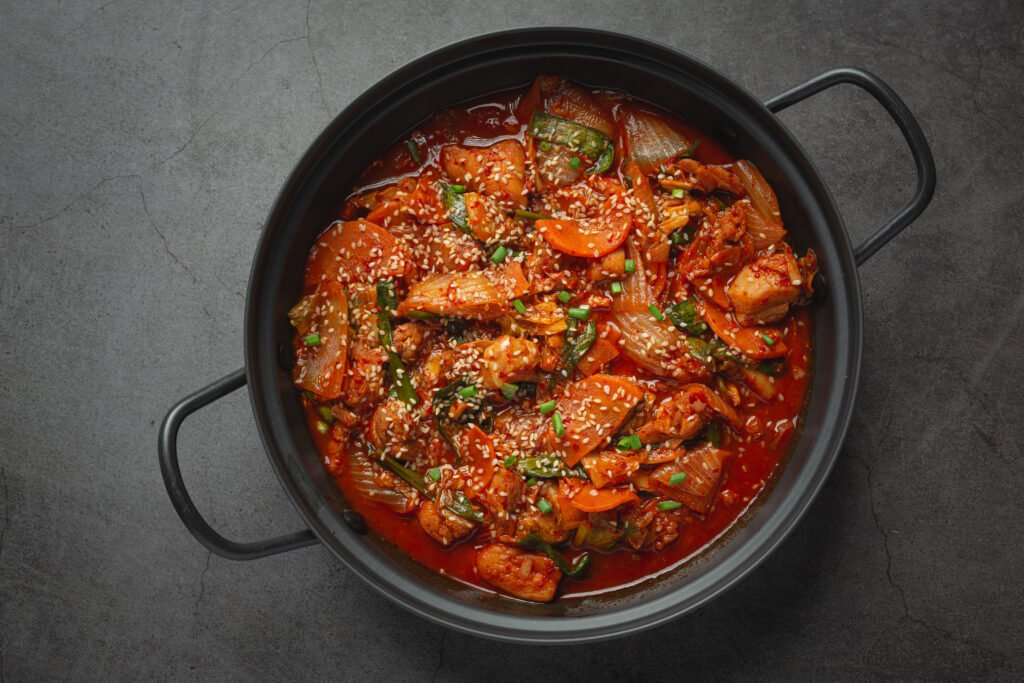
Escargots de Bourgogne: Conquering the Snail Frontier
- Brush snails with garlic-butter marinade
- Toast in a hot iron skillet until fragrant
- Serve with crusty pain d’épices
Your first try at how to prepare Escargots de Bourgogne will be a mess—until a chef in Dijon shows you the cuillère à escargots (special snail spoon). Now, enjoy the snails’ silky texture, opening up to Burgundy’s culinary traditions.
These dishes are more than food—they’re conversations between the land and your taste buds. Each bite tells stories of vineyards, stone kitchens, and hands that have shaped Burgundian flavors for centuries.
Cheese Treasures: Comté and Beyond
Walking into a Comté aging cave, you can feel the cool, earthy air. Witness raw milk turn into art. The walls are lined with aging Comté cheese, each wrapped in cloth like a treasure.
A fourth-generation affineur shows how time changes the cheese. Summer wheels taste like hazelnut and caramel. Winter wheels have a toasted wheat flavor. It’s like magic—terroir in every bite.
“The ash line isn’t just tradition—it’s a time capsule,” said Hélène, shaping Morbier in a family dairy. She explains how cheesemakers once used ash to preserve curds overnight, now a signature of this two-layer marvel. Tasting Morbier, you detect earthy undertones with a citrusy snap near the ash line—proof that practicality and poetry can coexist.
Cancoillotte captures the region’s heart. At a farmhouse in Lons-le-Saunier, Madame Girard mixes this creamy cheese with white wine. It’s tangy with garlic. Find it at Besançon markets or where to buy Cancoillotte online.
Each French mountain cheese varieties has its own story. Comté is nutty, Morbier layered, and Cancoillotte warm. These cheeses are more than food—they’re a testament to patience and passion.
Wine Pairings That Transcend Expectations
Begin your adventure into Bourgogne-Franche-Comté’s wine world in a dim cellar, where candlelight flickers over bottles of Burgundy wine tours. Philippe,a guide, pours a Grand Cru Burgundy tastings from a 1999 Clos de Tart. Its smooth texture match pairs well with a slow-cooked beef.
“These wines are the region’s heartbeat,” he says, touching the cellar’s cool stone walls. The terroir here is alive—soils that shape grapes also feed the snails and the Comté’s nutty flavor.
“Pairing is not math—it’s dialogue between land and liquid,” Philippe insists as visitors taste a buttery Meursault beside truffled poultry. His words shows why Bourgogne’s wines are made for their dishes.
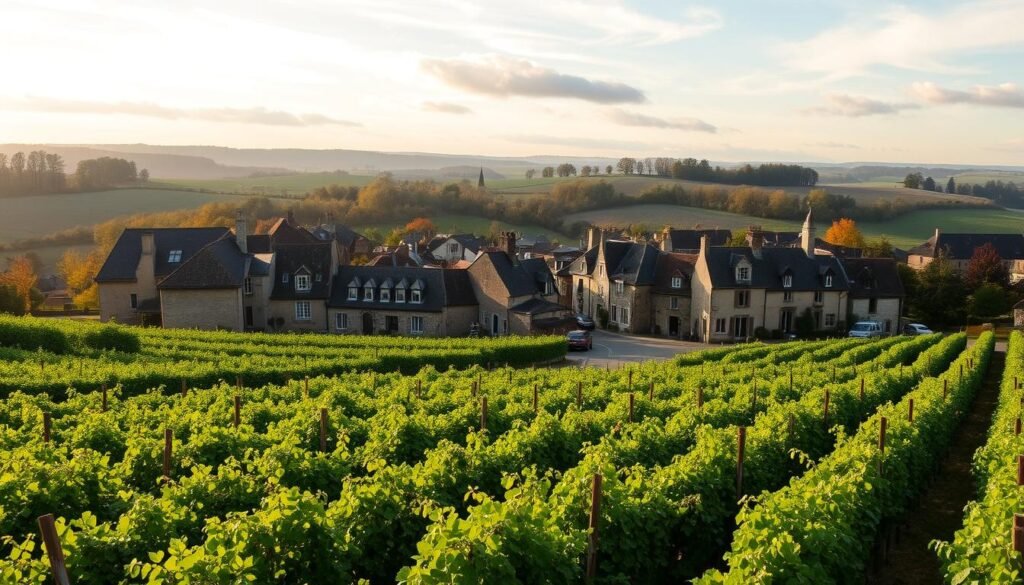
The Jura’s vin jaune Franche-Comté amazes the most. Its sherry-like taste clashes with your palate at first. But with 24-month Comté, umami fireworks exploded—nutty, salty, and oxidative flavors merged.
This Jura wine pairings discovery shows how local winemakers innovate while staying true to their roots. Young sommeliers now pair crisp Arbois whites with smoked sausage. This proves tradition can evolve without losing its essence.
- Grand Cru Burgundy tastings show how pinot noir’s earthy tannins match wild mushroom ragouts
- Lean, citrusy Aligoté cuts through the richness of escargots’ herb butter
- Vin jaune Franche-Comté’s golden tears complement Maroilles cheese’s pungency
Every sip here teaches you about terroir’s poetry. Exploring these vineyards is like tasting centuries of wisdom—Epicurean Escape’s tours let you experience this magic. The region’s wines are more than drinks; they’re the liquid echo of every plowed row and aged cheese wheel.
Lesser-Known Delicacies Worth Discovering
Exploring Bourgogne-Franche-Comté’s food scene, discover hidden gems. Poulet de Bresse is like the luxury car of chickens. To enjoy its soft meat, find it in markets with the red shield of AOC.
These birds eat insects and bask in sunlight. They show the region’s love for the land.
- Look for cobalt-blue leg bands on live birds at local fermes
- Ask charcutiers in Beaune or Dijon for unique Burgundy food specialties like this heritage breed
Poulet de Bresse: The Rolls-Royce of Chickens
Its taste is rich and earthy, like the limestone it lives on. Chefs roast it slowly over wood, making the skin golden.
Jambon Persillé: A Mosaic of Flavors
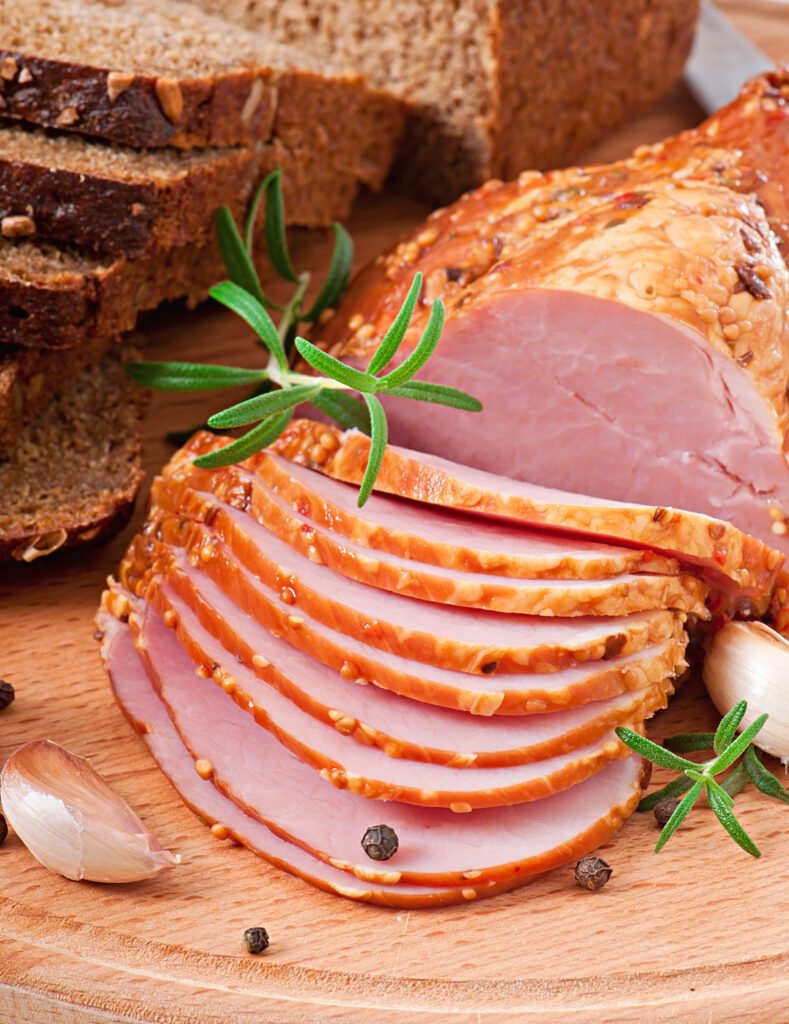
In Dijon, you’ll learn how they make authentic Jambon Persillé recipe. They stack cured ham with parsley gelée, creating a beautiful pattern. This dish comes from old fasting days and is loved at parties.
Absinthe from Pontarlier: The Forbidden Spirit
Pontarlier’s distilleries, like Pernod Ricard and Edouard Pernod, bring back the green spirit. Tours show how to make “louche,” watching the drink turn green as you add water.
| Specialty | Origin | Must-Experience |
|---|---|---|
| Poulet de Bresse | Bresse region | Whole roasted at La Mère Cateline in Beaune |
| Jambon Persillé | Burgundy | Pair with mustard from Gray or a glass of Marc de Bourgogne |
| Absinthe | Pontarlier | Distillery tastings with herbal infusions |
Modern Interpretations of Traditional Burgundian Recipes

At L’Espérance in Saint-Père-sous-Vézelay, chef Antoine Laurent transforms Boeuf Bourguignon into a stunning dish. It’s a mix of gelées and smoked root vegetables. This French-American fusion cooking shows how modern French cuisine respects tradition but also breaks new ground. Young contemporary Burgundy chefs like Laurent use new methods to make classic dishes lighter but just as flavorful.
At Dijon’s Le Jardin Gourmand, chefs are pushing the limits of Burgundian cuisine. They add truffle-infused consommés over deconstructed escargots. Chef Élodie Moreau says, “We’re not throwing out tradition, but making it fresh again with new textures.” Her modern French cuisine combines old and new, like nitrogen-chilled crème de cassis sorbet with Comté.
“The best fusion doesn’t shout, it whispers connections,” said New York chef Clara Voss, who trained at Hospices de Beaune. Her New York bistro now serves coq au vin with Carolina redbird peppers, embodying French-American fusion cooking that thrives on cross-continental dialogue.
In Burgundy, chefs are aging wine in oak barrels for just 48 hours, a big change from years ago. Michelin-starred innovative Burgundian restaurants are using local chestnuts in pâté. This shows how the region’s chefs are updating menus while keeping the past alive. Each dish is a journey, connecting old and new flavors.
Where to Experience Authentic Regional Cuisine in Bourgogne-Franche-Comté
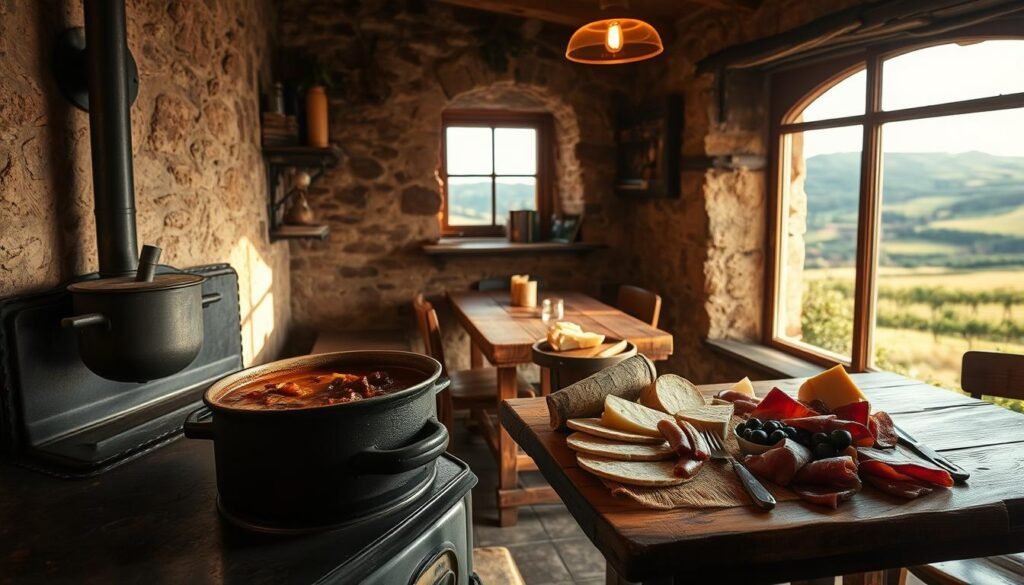
In Dijon, you come to understand that the best restaurants in Burgundy are often hidden. Marie’s favorite cheese shop in Ornans has wheels of Comté aging in cellars for centuries. It shows the true spirit of authentic Franche-Comté dining.
These spots are where locals go every week. Their menus are a part of the community’s history.
“The true taste of Burgundy lives where the plates are served with stories,” said Hélène, a vineyard owner who introduce visitors to La Grilladine—a Beaune gem where hearth-roasted game fills the air with autumnal scents.
This journey reveals three essential places:
| Name | Specialty | Highlight |
|---|---|---|
| La Grilladine | Wood-fired game dishes | Seasonal menus paired with biodynamic wines |
| Maison Vachet | Traditional Charolais beef tartare | Family-owned for 80 years, no reservations accepted |
| Les Jardins de la Métairie | Foraged vegetable dishes | Meals prepared using heirloom recipes from the Jura mountains |
But there’s more to Burgundy culinary experiences than these places. At Dijon’s food tours, guides like Jean-Paul lead truffle hunts. In Franche-Comté, cheesemaking workshops let visitors make Comté with affineurs.
These moments are more than meals. They’re conversations between land and tradition. Visiting best restaurants in Burgundy starts with a handshake. Authentic Franche-Comté dining begins with a jar of preserved cherries.
Every bite here invites you to stay, learn, and appreciate the pride of keeping traditions alive.
Conclusion: Why Burgundian Gastronomy Leaves an Indelible Mark
That final evening under vineyard stars, sharing a meal with hands stained from picking grapes, shows Bourgogne-Franche-Comté’s true taste. This region’s culinary tourism France is more than recipes—it’s a conversation between terroir and time. The slow-cooked boeuf bourguignon simmering for hours show Burgundy’s patience.
Here, traditional French food culture is full of contrasts: escargots and absinthe meet simple cancoillotte. Every cheese aging in cellars, every winegrower tending vines, shows food heritage preservation. These traditions teaches you that great cooking is about trust in ingredients, time, and shared meals.
Now, your kitchen waits for the caramelization of onions, the crust of a jambon persillé. The region’s magic is in balancing old traditions with new ideas. To enjoy Bourgogne-Franche-Comté is to taste a philosophy: food connects generations and places.
